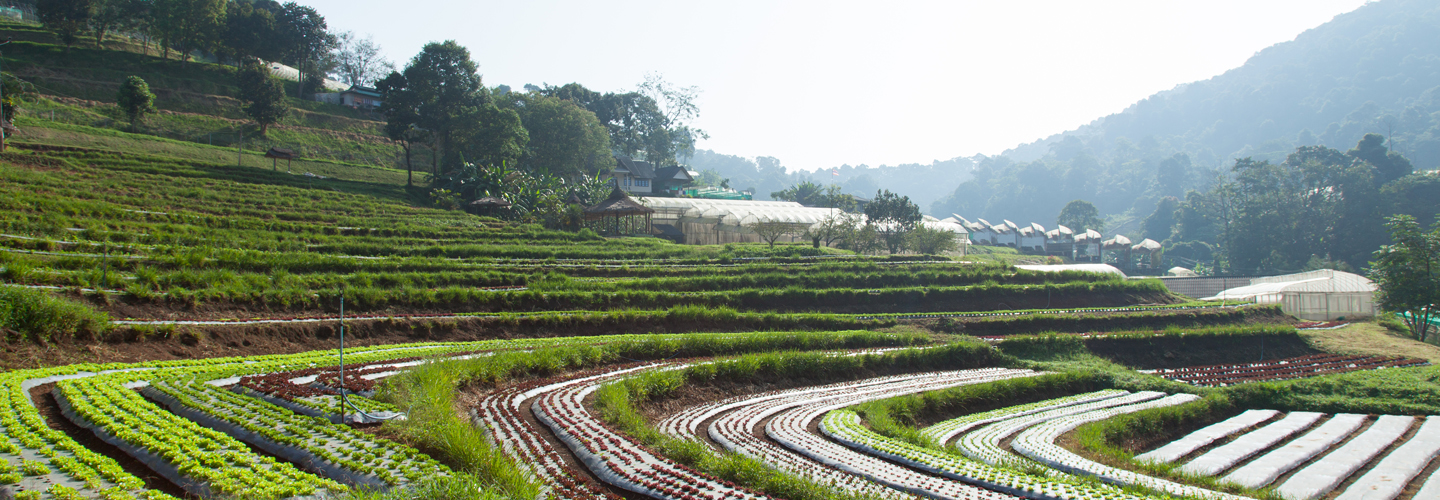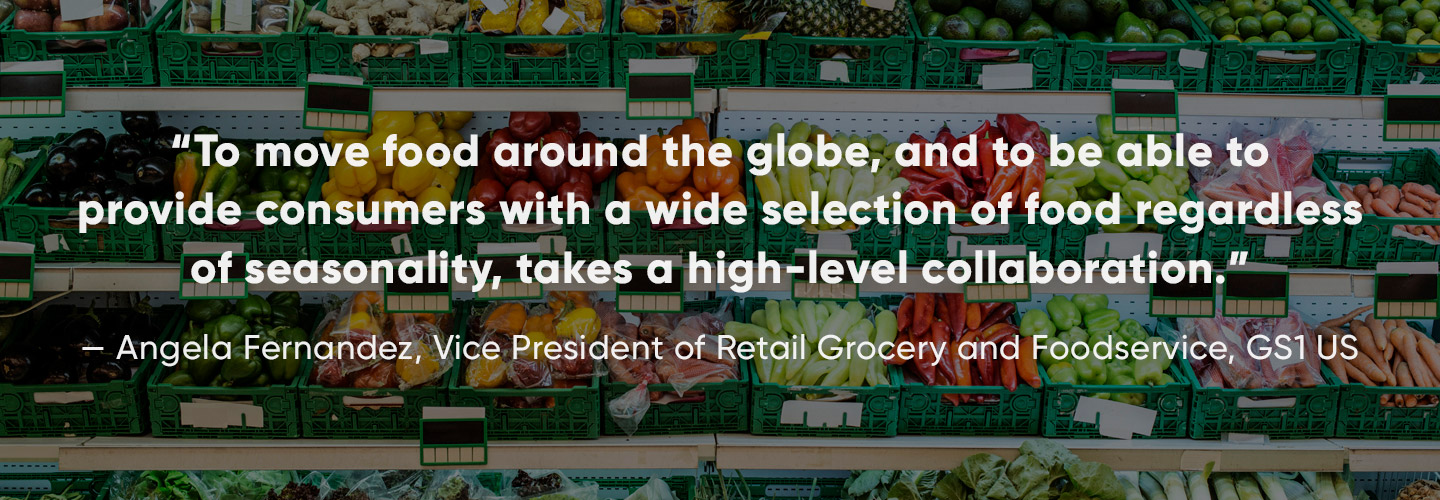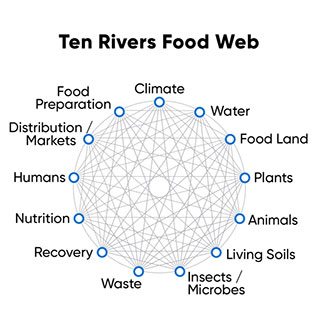Partners in Food
The global food system depends on a complex web of collaborative growers, manufacturers, distributors, governments and NGOs, now and in the future.

Farmer Harry MacCormack chuckles when he thinks of the good old days of life in the food chain. Back in 2004, everyone in Oregon’s Willamette Valley, where he operates Sunbow Farm, was talking about the importance of eating only food grown within a narrow geographical radius. The fad, known as the “100-mile diet,” was well-intentioned, he says. At its heart was an effort to support local farmers and boost food security.
At the time, MacCormack, the author of several books on food and farming, noticed a disconnect between concept and execution. Although he grew his organic vegetables, fruits, beans and grains near the supportive university town of Corvallis, there weren’t enough customers there to sustain his business. He was forced to rely on sales in larger population centers such as Portland, almost 90 miles away, and beyond. A fair amount of the valley’s crop yield, in fact, had to be trucked out and processed, packaged and warehoused, traveling far more than 100 miles in the process. While there is an undeniable romance to the simple roadside farm stand, the reality is far more complex, involving many interlocking puzzle pieces.
So MacCormack and some other farmers starting thinking about the connections that link the players involved in growing and moving food around the region. The process is complex and growing ever more so—a spider web of connectivity that often involves not just farmers but also government policymakers and NGOs and technology companies and academics and philanthropists, among others. Their epiphany? You can’t change one link in the chain without affecting all the others.
That’s what led them to create the Ten Rivers Food Web. The idea was simple: Rather than everyone worrying about their own turf, they would get together and scrutinize every step in a journey that begins with a seed in the ground and ends on a consumer’s fork. “It’s a highly integrated process,” MacCormack says, “that all starts with water and soil and air.” From those natural elements, it takes a lot of partnerships to get the food where it needs to go.
Sprouting collaborations
Whether they’re part of a regional organization like Ten Rivers or they come about as a result of a large international trade agreement involving massive amounts of crops, partnerships are essential in carrying out the goals and missions of the food webs that nourish our world.
Whether part of a regional organization or a result of large international trade agreements, partnerships are essential in carrying out the goals and missions of the food webs that nourish our world.
That’s no surprise, given the sheer size and complexity of our global food web, which brings grapes grown in Chile to tables in Chattanooga as smoothly as it ships millions of tons of soybeans from Brazil to China. It’s a process that requires an almost unimaginable level of integration and timing and collaboration, carried out across thousands of miles and hundreds of billions of dollars. Factor in geopolitics and the intricacies of global trade agreements, and it’s a wonder that it ever works at all.
Consider the web that speeds those Chilean grapes north. At the highest level, it begins with cooperation between each nation’s government, in this case a 2003 free-trade agreement. From there, everything revolves around Subsole, a cooperative of prominent Chilean fruit growers founded in the 1990s. Several years ago, Subsole entered into a pilot partnership with a variety of interests built around ensuring the fruit gets where it needs to go.
Here’s how it works: Various buyers in the U.S. put in orders, including Associated Grocers of Baton Rouge, which distributes to retailers across the southern U.S. The grapes are packaged in two-pound clamshell containers and moved to Subsole’s cold-storage warehouses at the port of Valparaiso, then shipped to the port of Wilmington, Del. At sea, the shipper communicates with both the buyer and Subsole by scanning bar codes on each pallet of grapes as to the timetable and condition of the fruit.
The key to this communication among all parties is the Global Trade Item Number (GTINs) stamped on each crate, provided by GS1, a non-profit organization that develops and maintains efficiency and transparency standards in the global supply chain. GS1 provides bar-code technology that tracks shipments from the fields all the way to the shelf or plate.
“To move food around the globe, and to be able to provide consumers with a wide selection of food regardless of seasonality, takes a high-level collaboration,” says Angela Fernandez, vice president of retail grocery and foodservice for GS1 US. “Although some consumers are pushing for locally grown food, many major companies are also sourcing food globally, which makes our food supply chain much more complex. We’ve got to work together to ensure food stays safe along that path.”

This standardized identification—as opposed to proprietary identification numbers that don’t translate outside of a company’s four walls—has other important features, Fernandez says. Like safety. In the event of a food recall, the technology can immediately isolate what was contaminated, preventing further distribution to consumers and reducing unnecessary costs. The system helped officials to identify the romaine lettuce crop that caused an E-coli outbreak in the U.S. early in 2018, preventing other growers from having to destroy their crops. Retailers, for their part, can immediately receive notifications on expiration dates and recalls, a clear boon for consumers.
Future shock
With so many moving parts, however, the global food system is by no means invulnerable. According to the 2022 edition of the Global Food Security Index (GFSI), published by Economist Impact, the world’s overall food security has declined for a third year in a row, making the food system and vulnerable populations susceptible to shocks. The report, which ranks countries in terms of their food availability, quality and safety, affordability, and sustainability and adaptation, highlights the delicacy of these intricate webs.
The Aspen Institute’s Food Strategy Security Group, meanwhile, recently cited “a new norm of volatility” in food markets across the globe due to factors ranging from political instability to climate change. The solution to greater food security, it concluded, is “a closely coordinated effort at the highest levels of leadership in the public and private sectors.” A recent University of Michigan study echoed that sentiment, noting that “the current global food system is inadequate to meet the needs of the current world population without compromising future well-being” and calling for more partnerships, more cross-pollination from governments and farming disciplines and other stakeholders.
The good news is that around the world, surprising new collaborations are manifesting in countless different ways. “Food is inherently something that brings people together, and a lot of partnerships are needed right now,” says Emilie Englehard, the senior director for external affairs at the Fair Food Network, an organization working to enhance food economies. “Right now you’re going to find that there are a dynamic group of partners at the table with these issues, finding common ground.”
Take, for instance, the scientists from the Massachusetts Institute of Technology who are modeling crop outputs in African countries most impacted by climate change. The researchers overlaid global climate predictions onto an open-source crop model that simulates yields over successive growing seasons. They found that central and southern Africa—areas that produce a large amount of the continent’s corn—will become increasingly drought-stricken, which in turn will reduce some crop yields by more than 20 percent. This in a region where more than 300 million people count on corn as their main food source.
What to do? Aside from the bleak headlines, the scientists offered a blueprint of sorts from which farmers and government leaders can plan ahead of the changes, says Kenneth Strzepek, a co-author of the paper and research scientist in MIT’s Joint Program on the Science and Policy of Global Change. The data can help reveal critical information such as which areas will be so dry in 20 years that irrigation will be mandatory. “Governments want to be bold and build infrastructure in certain regions, but in 30 years can we afford to have [that infrastructure] be stranded?” Strzepek says. “The kind of results that are coming out of this study are valuable in how [development] moves forward.”
Meanwhile, agencies like the International Institute of Tropical Agriculture, based in Nigeria, are working to coax farmers to replace corn with alternative staples—sorghum, cassava, and sweet potato, among others—that thrive in drier conditions. And its scientists are scrambling to engineer more drought-resistant crops, breeding and cross-pollinating seeds to make species more adept at growing in arid regions, sometimes by maturing quicker.
Over in Kenya, women with livestock recently began feeding their cattle native grasses rather than corn, which has delivered greater milk output. They learned to do this as part of a program funded by the United States Agency for International Development and run by Heifer International and the Kenya-based International Livestock Research Institute that promotes such practices to help cows make more milk and less methane. All those groups working together delivered a way to at once help women farmers out of poverty, improve milk supplies, and help the planet.
Smoothing the path
Whether it’s down the road or on the opposite side of the globe, all farms have one important common bond: They face new challenges thanks to climate change, which is rapidly reshaping not just how we grow food but how successfully we grow it.
One study published recently by scientists at the London School of Hygiene and Tropical Medicine showed that a rise in the world’s average temperature of 4°C by the year 2100 could trigger a 35 percent drop-off in vegetable and legume production. Another set of researchers at the Potsdam Institute for Climate Impact Research recently reported that the same temperature increase could halve the corn output in the U.S. by the end of the century. This is worrisome, given the fact that the world already struggles to feed its current inhabitants—and the world’s population is only expected to grow.
In many instances, the answers center on collaborations to develop new technologies not available even a few years ago. Some of it involves infrastructure tools like shipping containers: Grappling with the challenge of keeping fruit from rotting during its long journeys around the globe, one company developed a container system that provides an optimal atmospheric blend of oxygen, carbon dioxide, and nitrogen to keep blueberries fresh.
But much other innovation comes from mobile and remote data-collection technology. The financial sector is doing its share by offering forecast-based financing, which uses climate forecasts to anticipate a drought or flood to trigger loans that help vulnerable communities deal with the aftermath of climate disasters.
In Singapore, the government is working with universities and the private sector to solve a unique problem: The island nation imports more than 90 percent of its food, says Md Saidul Islam, a professor of sociology and coordinator of the Environment and Sustainability Research Cluster at Singapore’s Nanyang Technological University. That means that despite its wealth, its food supplies could be impacted by food-exporting countries struggling with climate-related shortages.
“There was a time in Singapore when money could buy everything, but that’s a thing of the past,” says Islam, who has studied whether the country is resilient enough to deal with various climate-based challenges, including food security.
Now the nation’s leaders are focusing on diversifying their imports to ensure that a disaster in one part of the world doesn’t wipe out their pipeline. Singapore is also deep into research and development efforts to find technology-based ways to generate more of its own food within its tight confines, through techniques like vertical farming and hydroponics.
Only connect
The best part of the thousands of partnerships now bolstering the food webs all around the world: They’re leading to solutions and innovations that no one stakeholder could come up with alone.

Remember Ten Rivers Food Web, in Oregon’s Willamette Valley? After accepting that the concept of the 100-mile diet was unrealistic, and that food needed to be shipped further afield for farmers to survive, they adopted 12 pillars of focus—a top-to-bottom approach that encompasses human health and nutrition; the health of the soil, water, and other natural resources; and the preservation of land for growing food. It’s the same set of elements that the food system relies on everywhere.
MacCormack and another member, John Gentile, even took a hard look at transportation. Rather than accept the use of fossil-fuel-burning tractor trailers, the food-web members decided to try for something better. Their idea: Vehicles that ran on fuel created from ocean plastic and municipal waste collected from around the region. “The idea was to set these up so that they can scale up for a big operation or down for use by a small farm,” MacCormack says. “It’s amazing when you start seeing the reality of how much the food we grow moves around, but we realized we can do this in a way where there’s no waste.”
After spending a year working with engineers all over the country, they started a company called Cascadia Energy Technologies. They brought in partners from the banking and investment community. Each site for a proposed clean-fuel plant will have local involvement, which means teaming up with various country and city officials. A community college is involved with the initiative through Ten Rivers Food Web. It’s just one of countless collaborative initiatives intended to lead our communities toward the same goal: ensuring that the food on our plates is secure, nutritious, and grown as locally as possible.
Such partnerships are clearly the way forward, because ultimately we’re all in this together, MacCormack says. “It’s pretty crucial, because things are changing so fast.”
Additional Links